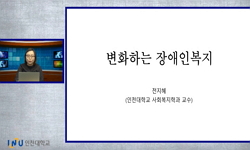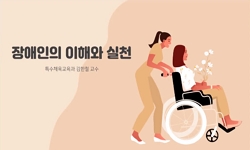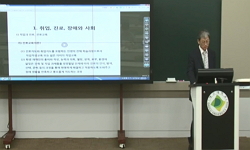본고는 조선시대 장애사를 올바르게 해석하기 위한 역사적 토대를 마련하기 위한 것이다. 먼저 『경국대전』을 통해 조선시대 장애 복지법을 살펴본 다음, 전근대 장애인의 기본적인 생존 ...
http://chineseinput.net/에서 pinyin(병음)방식으로 중국어를 변환할 수 있습니다.
변환된 중국어를 복사하여 사용하시면 됩니다.
- 中文 을 입력하시려면 zhongwen을 입력하시고 space를누르시면됩니다.
- 北京 을 입력하시려면 beijing을 입력하시고 space를 누르시면 됩니다.

조선시대 장애 복지법과 자립 정책 = Disability Welfare Act and Self-reliance Policy during the Joseon Dynasty
한글로보기부가정보
국문 초록 (Abstract)
조선시대엔 장애를 단지 ‘병’으로 보았고, 그 정도에 따라 잔질, 폐질, 독질로 구분했다. 조선은 장애 개념과 복지를 국법인 『경국대전』에 명시할 정도로 국가적으로 제도화했다. 그렇다고 모든 장애인에게 무조건적인 복지를 베푸는 것이 아닌, 기본적으로 각자의 기능에 따라 다양하게 일을 하며 제힘으로 먹고 살도록 하는 자립주의 정책을 펼쳤다. 그와 동시에 장애보다는 개인의 능력을 더욱 중시함으로써 장애/비장애의 구분 없는 통합사회를 만들어갔다. 비록 신분에 따라 차이가 있긴 했지만, 조선시대 장애인이 사회 속에서 다양하게 활동하며 역사의 한 축을 이루었던 것도 그 때문이다.
본고는 조선시대 장애사를 올바르게 해석하기 위한 역사적 토대를 마련하기 위한 것이다. 먼저 『경국대전』을 통해 조선시대 장애 복지법을 살펴본 다음, 전근대 장애인의 기본적인 생존 방식인 자립주의 정책과 그들의 다양한 활동상에 대해 개괄적으로 살펴보았다.
조선시대엔 장애를 단지 ‘병’으로 보았고, 그 정도에 따라 잔질, 폐질, 독질로 구분했다. 조선은 장애 개념과 복지를 국법인 『경국대전』에 명시할 정도로 국가적으로 제도화했다. 그렇다고 모든 장애인에게 무조건적인 복지를 베푸는 것이 아닌, 기본적으로 각자의 기능에 따라 다양하게 일을 하며 제힘으로 먹고 살도록 하는 자립주의 정책을 펼쳤다. 그와 동시에 장애보다는 개인의 능력을 더욱 중시함으로써 장애/비장애의 구분 없는 통합사회를 만들어갔다. 비록 신분에 따라 차이가 있긴 했지만, 조선시대 장애인이 사회 속에서 다양하게 활동하며 역사의 한 축을 이루었던 것도 그 때문이다.
다국어 초록 (Multilingual Abstract)
In the Joseon Dynasty, disability was regarded as a simple ‘disease’, and according to the degree, it was classified into Janjil(殘疾, a lingering disease in the body), Pyejil(廢疾, an incurable disease), and Docjil(篤疾, a highly critical disease). Joseon institutionalized the concept of disability and welfare nationally to the extent that it was specified in the national law 『Gyeonggukdaejeon』. However, rather than providing unconditional welfare to all disabled people, it basically implemented an independence policy that allowed them to work in various ways according to their functions and live on their own. At the same time, by placing more importance on individual abilities than disabilities, an integrated society was created without distinction between disabilities and non-disabled people. Although there were differences according to their status, it was for that reason that the disabled in the Joseon Dynasty worked in various ways in society and formed an axis of history.
This paper is to lay the historical foundation for correctly interpreting the history of disability in the Joseon Dynasty. In particular, after examining the Welfare of Disabilities Act of the Joseon Dynasty through 『Gyeonggukdaejeon』, the policy ...
This paper is to lay the historical foundation for correctly interpreting the history of disability in the Joseon Dynasty. In particular, after examining the Welfare of Disabilities Act of the Joseon Dynasty through 『Gyeonggukdaejeon』, the policy of self-reliance, which is the basic way of survival for the disabled in the premodern period, and their various activities were outlined.
In the Joseon Dynasty, disability was regarded as a simple ‘disease’, and according to the degree, it was classified into Janjil(殘疾, a lingering disease in the body), Pyejil(廢疾, an incurable disease), and Docjil(篤疾, a highly critical disease). Joseon institutionalized the concept of disability and welfare nationally to the extent that it was specified in the national law 『Gyeonggukdaejeon』. However, rather than providing unconditional welfare to all disabled people, it basically implemented an independence policy that allowed them to work in various ways according to their functions and live on their own. At the same time, by placing more importance on individual abilities than disabilities, an integrated society was created without distinction between disabilities and non-disabled people. Although there were differences according to their status, it was for that reason that the disabled in the Joseon Dynasty worked in various ways in society and formed an axis of history.
동일학술지(권/호) 다른 논문
-
- 민족문학사연구소
- 이지훈
- 2024
- KCI등재
-
- 민족문학사연구소
- 안미영
- 2024
- KCI등재
-
민족 통일 논의와 아리랑을 둘러싼 경합: 1991년 남북단일팀 단가 결정에서 유네스코 등재까지
- 민족문학사연구소
- 임경화
- 2024
- KCI등재
-
국문장편소설 감정 데이터 모델링의 현실적 방안 고찰: 감정분류체계 정립을 중심으로
- 민족문학사연구소
- 강우규
- 2024
- KCI등재




 KCI
KCI KISS
KISS






